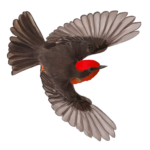About
Discover The Lower Colorado River
About the River
The Colorado River, once an untamed ribbon of life, flows from the Rocky Mountains in western Colorado through the Grand Canyon and then meanders south, passing into Mexico and finally reaching the Gulf of California. The sign over the Hoover Dam reads "a vision of lonely lands made fruitful," signaling the bounty of water created by taming the river into one of the most regulated rivers in the world.
Damming of the Colorado River began in the early 1900s; the famous Hoover Dam was created in 1935 and formed Lake Mead in the lower basin, and then Glen Canyon Dam formed Lake Powell in the upper basin. Both dams account for 85% of the entire basin's storage capacity and provide water for 25 million people and two million acres of irrigated farmland. Nine dams exist in the lower basin, which helps provide water to 40 million people (Conway et al., 2010).
The Colorado River offers a corridor of life for hundreds of wildlife species by creating critical wetland and riparian forest habitats. This outreach project provides information about the natural history of the lower Colorado River basin and one of its tributaries, the Bill Williams River, one of the last sections with extensive stands of native Fremont cottonwood and Gooding willow.
The Bill Williams River flows through the Sonoran Desert in western Arizona. At 65 kilometers long, this tributary flows westward to the Colorado River. In 1993, an almost 2,500-hectare area, about 14.5 kilometers of the river, was selected to become the Bill Williams National Wildlife Refuge. The NWR is actively managed for wildlife through invasive species control, restoration and creation of riparian habitat, prescribed fire, and monitoring of plants and wildlife. A diverse array of wildlife calls the Bill Williams home, including 34 reptile species, 57 mammals, including bighorn sheep and cougars, seven amphibians, 40 species of butterflies, 192 aquatic species, and over 355 bird species. Along with being one of the last remaining stands of native cottonwoods along the lower Colorado River, this NWR serves as an IBA (Important Bird Area) and as a stopover for migratory Neotropical birds as well as a breeding grounds for many birds, including endangered species such as the western DPS (distinct population segment) yellow-billed cuckoo, Yuma Ridgway's rail, and southwestern willow flycatcher (Alder, 2007).

About the LCR MSCP
In 2005, a program was launched to achieve habitat restoration and creation, the Lower Colorado River Multi-Species Conservation Program (LCR MSCP). This 50 year-plan works with 57 different agencies and covers 27 species listed under the Endangered Species Act or may be at risk for listing. The LCR MSCP works towards a collaborative goal to conserve native species and their habit along the river and recover listed and threatened species under the ESA and reduce the chance of future species listings. Many native species of the region's breeding bird populations have declined in the past century, with the most impacted being those reliant on cottonwood-willow forests (Rosenberg et al., 1991). Bird species of concern included on the LCR MSCP are the Arizona Bell's Vireo, Gila Woodpecker, Gilded Flicker, Sonoran Yellow Warbler, Southwestern Willow Flycatcher, Summer Tanager, Western Yellow-Billed Cuckoo, California Black Rail, Western Least Bittern, Yuma Ridgway's rail, Vermilion Flycatcher, and Elf Owl.
About the Birds

Birds reach every corner of our planet and are an integral part of a functioning ecosystem. They provide ecosystem services such as removing carcasses by vultures or raptors balancing prey populations (e.g., rodents) near agriculture. Aside from tangible benefits to humans, birds serve as cultural symbols and human inspiration. When I mention that I study birds, people tell me about their personal experiences with birds. It is always a positive experience, from watching a bird feed its nestling to feeling the presence of a bird signifies good fortune.
Since 2007, birds have been monitored along the riparian corridor of the Lower Colorado River as part of the LCR MSCP. The federally listed western yellow-billed cuckoo, southwestern willow flycatcher, and marsh birds are monitored in single-species programs. The Great Basin Bird Observatory monitors the remaining species. The Great Basin Bird Observatory is a non-profit organization of scientists with the mission "to further bird conservation in the Great Basin and adjoining regions through applied research, partnerships, and education." Riparian birds are monitored along the LCR MSCP stretch of river from Lake Mead down to Yuma, Arizona, in conservation areas (i.e., the habitat preservation, restoration, or creation sites) and random plots to act as control sites. Long-term monitoring goals include defining habitat characteristics for target species, tracking populations statuses over time, and understanding response to created habitats to recommend adaptive management strategies for habitat creation and restoration.
The data Great Basin Bird Observatory has collected showed increases in some species from prior research by Grinnel (1910) and research conducted from 1974 to 1984 along the LCR (Rosenberg, 1991). The Sonoran Yellow Warbler and Arizona Bell's Vireo appear to be rebounding; however, the Gilded Flicker is nearly extirpated from most of its historical range. Some target species such as the Sonoran Yellow Warbler, Summer Tanager, Arizona Bell's Vireo, and Vermilion Flycatcher are using restored and created habitat sites. However, the use of created habitat sites is less than that of restoration sites. Further research will help address if more time is necessary for conservation or if other variables are the cause (Fletcher et al., 2019).
Fly over the Bill Williams River
Drone coverage of the Bill Williams River courtesy of Keith Brennan during our work studying Yellow-billed Cuckoos in 2018. Can you identify any of the birds singing in the background? Drone coverage obtained with special use permit through Bill Williams NWR.